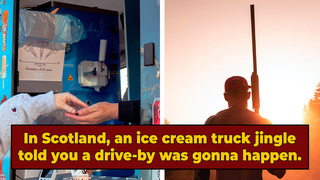The Glasgow Ice Cream Wars Traded Sprinkles For Shotguns

With trick or treating effectively canceled this year, many a helicopter parent can breathe a sigh of relief that they won't have to X-Ray each piece of proffered candy to see if it contains anything dangerous like poison, razor blades, or socialism. But those parents don't know the true dangers that the arrivals of sweet treats can bring to your door. Not unless they're from Scotland, where once hearing an ice cream truck jingle told you a drive-by shooting was about to happen.
At times, Glasgow is the kind of place where not getting your throat slashed with a glass pint is considered a warm welcome, and the '80s weren't a sunshine period for the Scottish city. The decade had seen the rise of housing flats, the U.K. equivalent of housing projects, where Glasgow's least fortunate were crammed together far away from police patrol areas. As a result, there were no shops crazy enough to open within walking distance (and the average walking distance was measured in how many steps taken before getting stabbed) of the flats, starving the inhabitants of everyday luxuries like cigarettes, newspapers, cigarettes, candy, cigarettes, and candy cigarettes.
Don't Miss
This proved to be a booming business opportunity for ice cream trucks. These already mobile shops could navigate between nasty neighborhoods and deliver some much needed soft serve to soothe the hard life of the council flat dwellers. Having a good route quickly became so lucrative, Glaswegian ice-cream sellers occasionally got into bloody brawls over who got the best streets.

But this success story attracted another kind of ice cream patron than the average pre-diabetic kid: gangs. These saw ice cream trucks as the perfect cover to sell illegal goods like stolen merchandise and drugs from -- because who would ever suspect a stranger in a windowless van who hands out ice cream to kids to be up to no good? This rapidly ramped up the route fights into total turf wars, with gangs terrorizing honest working-class drivers with knives, bats, and even shotguns, and it wasn't uncommon for someone's van to get a few scoops of buckshot sprinkled into it as a warning to stay in their lane.
While the ice cream wars still sound silly and whimsical, these frosty gang wars went down a dark and rocky road. On April 16th, 1984, after driver Andrew "Fat Man" Doyle had withstood several shotgun-based intimidation attempts from a local gang, assailants set fire to his council flat. In the resulting blaze, six Doyle family members perished, including two teens and an 18-year-old baby. While two men, Thomas Campbell and Joe Steele, were found guilty of the murders, it turned out that their conviction was based on false testimony, and the men were set free, with the real ice cream killer having never been caught by the often mocked "special chimes unit" of the Glasgow P.D.
Between the increased police presence after the Doyle massacre and the rise of corner shops, the Glaswegian ice cream truck craze melted away by the end of the start of the '90s, closing yet another chapter in the surprisingly dark, occasionally racist saga of the vans of creams.
For more half-melted tangents, do follow Cedric on Twitter.
Top Image: Callum Blacoe/Kyle Johnson, Unsplash